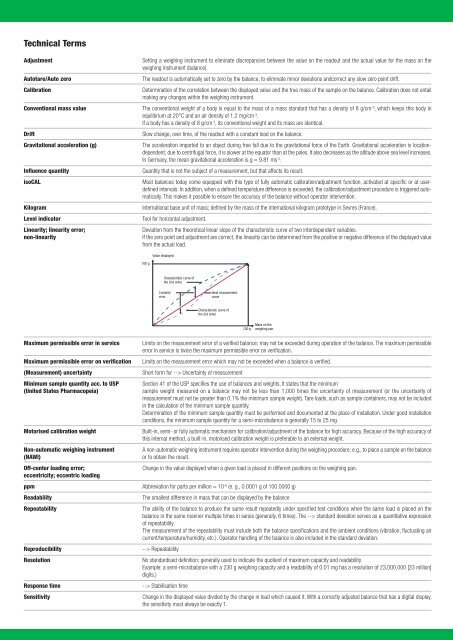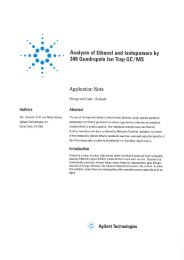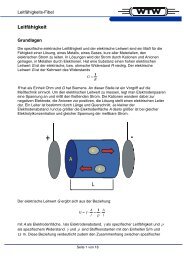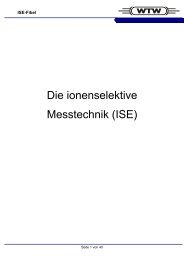Download PDF approx. 0,6 MB - Omnilab
Download PDF approx. 0,6 MB - Omnilab
Download PDF approx. 0,6 MB - Omnilab
Create successful ePaper yourself
Turn your PDF publications into a flip-book with our unique Google optimized e-Paper software.
Technical TermsAdjustmentAutotare/Auto zeroCalibrationConventional mass valueDriftGravitational acceleration (g)Influence quantityisoCALKilogramLevel indicatorLinearity; linearity error;non-linearitySetting a weighing instrument to eliminate discrepancies between the value on the readout and the actual value for the mass on theweighing instrument (balance).The readout is automatically set to zero by the balance, to eliminate minor deviations andcorrect any slow zero point drift.Determination of the correlation between the displayed value and the true mass of the sample on the balance. Calibration does not entailmaking any changes within the weighing instrument.The conventional weight of a body is equal to the mass of a mass standard that has a density of 8 g/cm -3 , which keeps this body inequilibrium at 20°C and an air density of 1.2 mg/cm -3 .If a body has a density of 8 g/cm -3 , its conventional weight and its mass are identical.Slow change, over time, of the readout with a constant load on the balance.The acceleration imparted to an object during free fall due to the gravitational force of the Earth. Gravitational acceleration is locationdependent;due to centrifugal force, it is slower at the equator than at the poles. It also decreases as the altitude above sea level increases.In Germany, the mean gravitational acceleration is g = 9.81 ms -2 .Quantity that is not the subject of a measurement, but that affects its result.Most balances today come equipped with this type of fully automatic calibration/adjustment function, activated at specific or at userdefinedintervals. In addition, when a defined temperature difference is exceeded, the calibration/adjustment procedure is triggered automatically.This makes it possible to ensure the accuracy of the balance without operator intervention.International base unit of mass; defined by the mass of the international kilogram prototype in Sevres (France).Tool for horizontal adjustment.Deviation from the theoretical linear slope of the characteristic curve of two interdependent variables.If the zero point and adjustment are correct, the linearity can be determined from the positive or negative difference of the displayed valuefrom the actual load.Maximum permissible error in service Limits on the measurement error of a verified balance; may not be exceeded during operation of the balance. The maximum permissibleerror in service is twice the maximum permissible error on verification.Maximum permissible error on verification Limits on the measurement error which may not be exceeded when a balance is verified.(Measurement) uncertaintyShort form for --> Uncertainty of measurementMinimum sample quantity acc. to USP Section 41 of the USP specifies the use of balances and weights. It states that the minimum(United States Pharmacopeia)sample weight measured on a balance may not be less than 1,000 times the uncertainty of measurement (or the uncertainty ofmeasurement must not be greater than 0.1% the minimum sample weight). Tare loads, such as sample containers, may not be includedin the calculation of the minimum sample quantity.Determination of the minimum sample quantity must be performed and documented at the place of installation. Under good installationconditions, the minimum sample quantity for a semi-microbalance is generally 15 to 25 mg.Motorised calibration weightBuilt-in, semi- or fully automatic mechanism for calibration/adjustment of the balance for high accuracy. Because of the high accuracy ofthis internal method, a built-in, motorised calibration weight is preferable to an external weight.Non-automatic weighing instrument A non-automatic weighing instrument requires operator intervention during the weighing procedure; e.g., to place a sample on the balance(NAWI)or to obtain the result.Off-center loading error;Change in the value displayed when a given load is placed in different positions on the weighing pan.eccentricity; eccentric loadingppm Abbreviation for parts per million = 10 -6 (e. g., 0.0001 g of 100.0000 g)ReadabilityThe smallest difference in mass that can be displayed by the balanceRepeatabilityThe ability of the balance to produce the same result repeatedly under specified test conditions when the same load is placed on thebalance in the same manner multiple times in series (generally, 6 times). The --> standard deviation serves as a quantitative expressionof repeatability.The measurement of the repeatability must include both the balance specifications and the ambient conditions (vibration, fluctuating aircurrent/temperature/humidity, etc.). Operator handling of the balance is also included in the standard deviation.Reproducibility--> RepeatabilityResolutionNo standardised definition; generally used to indicate the quotient of maximum capacity and readability.Example: a semi-microbalance with a 230 g weighing capacity and a readability of 0.01 mg has a resolution of 23,000,000 [23 million]digits.)Response time--> Stabilisation timeSensitivityChange in the displayed value divided by the change in load which caused it. With a correctly adjusted balance that has a digital display,the sensitivity must always be exactly 1.
















